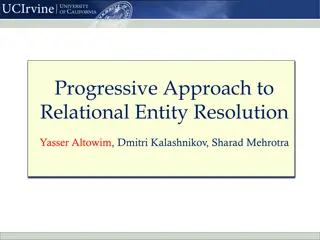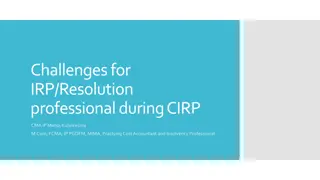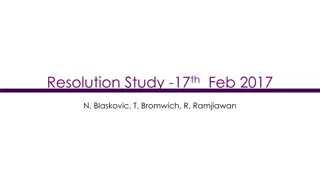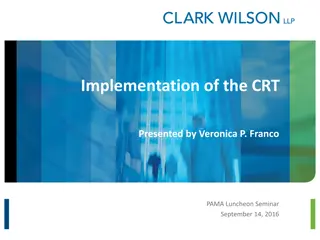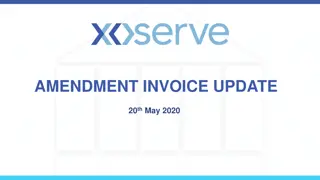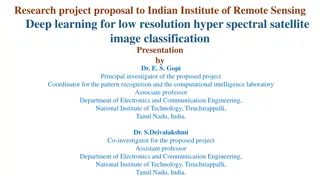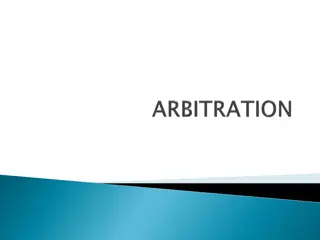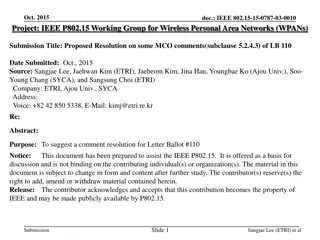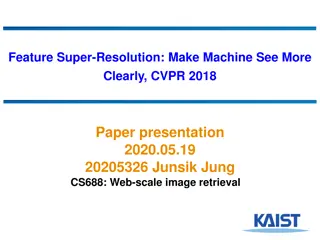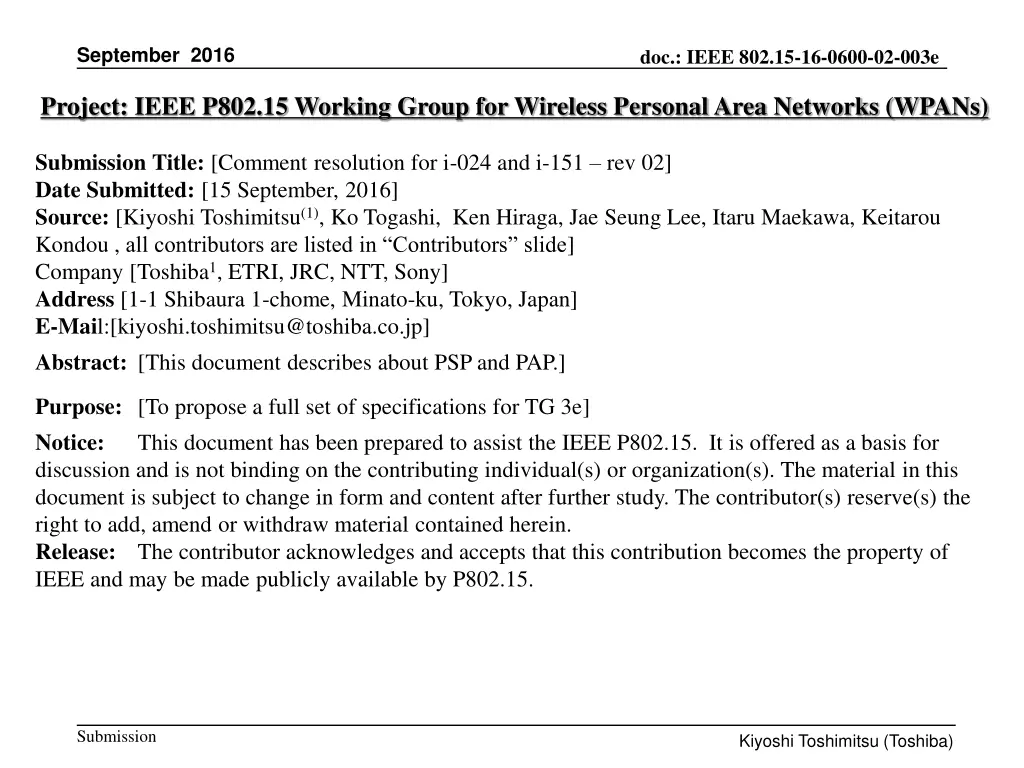
IEEE 802.15-16-0600-02-003e Revision Resolution
This document outlines resolution details for comments i-024 and i-151 regarding the definitions and depiction of phases in the IEEE 802.15-16-0600-02-003e project. It introduces new terms, PSP and PAP, while updating and clarifying existing terminology to align with the proposed specifications. The resolution also includes adjustments to Figure 4-2a for accuracy.
Download Presentation

Please find below an Image/Link to download the presentation.
The content on the website is provided AS IS for your information and personal use only. It may not be sold, licensed, or shared on other websites without obtaining consent from the author. If you encounter any issues during the download, it is possible that the publisher has removed the file from their server.
You are allowed to download the files provided on this website for personal or commercial use, subject to the condition that they are used lawfully. All files are the property of their respective owners.
The content on the website is provided AS IS for your information and personal use only. It may not be sold, licensed, or shared on other websites without obtaining consent from the author.
E N D
Presentation Transcript
September 2016 doc.: IEEE 802.15-16-0600-02-003e Project: IEEE P802.15 Working Group for Wireless Personal Area Networks (WPANs) Submission Title: [Comment resolution for i-024 and i-151 rev 02] Date Submitted: [15 September, 2016] Source: [Kiyoshi Toshimitsu(1), Ko Togashi, Ken Hiraga, Jae Seung Lee, Itaru Maekawa, Keitarou Kondou , all contributors are listed in Contributors slide] Company [Toshiba1, ETRI, JRC, NTT, Sony] Address [1-1 Shibaura 1-chome, Minato-ku, Tokyo, Japan] E-Mail:[kiyoshi.toshimitsu@toshiba.co.jp] Abstract: [This document describes about PSP and PAP.] Purpose: [To propose a full set of specifications for TG 3e] Notice: This document has been prepared to assist the IEEE P802.15. It is offered as a basis for discussion and is not binding on the contributing individual(s) or organization(s). The material in this document is subject to change in form and content after further study. The contributor(s) reserve(s) the right to add, amend or withdraw material contained herein. Release: The contributor acknowledges and accepts that this contribution becomes the property of IEEE and may be made publicly available by P802.15. Submission Kiyoshi Toshimitsu (Toshiba)
doc.: IEEE 802.15-16-0600-02-003e Contributors Name Affiliation Email Jae Seung Lee ETRI jasonlee at etri.re.kr Itaru Maekawa Japan Radio Co., Ltd. maekawa.itaru at jrc.co.jp Ken Hiraga NTT Corporation hiraga.ken at lab.ntt.co.jp Keitarou Kondou Sony Corporation Keitarou.Kondou at jp.sony.com Ko Togashi Toshiba Corporation ko.togashi at toshiba.co.jp Kiyoshi Toshimitsu Toshiba Corporation kiyoshi.toshimitsu at toshiba.co.jp Submission
September 2016 doc.: IEEE 802.15-16-0600-02-003e Comment i-24 The title of Figure 4-2a is inappropriate. In Section 7.4.4, PPAP is defined as occurring after Association, which is not correct. Comment i-151 In Figure 4-2a, having "- Stop Beacon" and "- Send Association Response instead" in the "Associated Phase" part of the figure is very confusing since they are actually a part of the unassociated phase. Resolution : Accept Resolution summary for i-024 1. Define two new terms: PSP and PAP. 2. Delete five existing terms: PPAP, Associated Phase, Unassociated Phase (and PPSP and PPPP introduced in rev 01) 3. Update all instances of these changes in the document. 4. Update Figure 4-2a to reflect the changes. Submission Kiyoshi Toshimitsu (Toshiba)
doc.: IEEE 802.15-16-0600-02-003e Definition of PSP and PAP 3.1 Definition Change to: Pairnet setup phase: Phase during which the pairnet beacon is active but pairnet devices are not yet associated. Pairnet associated phase: Phase during which pairnet devices are associated. 3.2 Acronyms and abbreviations Change to: PSP: Pairnet setup phase PAP: Pairnet associated phase Submission Kiyoshi Toshimitsu (Toshiba)
September 2016 doc.: IEEE 802.15-16-0600-02-003e Figure 4-2a Original version (old) Figure 4-2a One cycle of PPAP Submission Kiyoshi Toshimitsu (Toshiba)
doc.: IEEE 802.15-16-0600-02-003e Figure 4-2a Proposed Change (New version) PSP PAP Setup Time < 2ms Beacon Stop beacon Send Association Response command instead HRCP PNC can send beacon with new Next DEVID Multiple transmissions of Disassociation Request command under No-ACK policy are allowed Association Response command Beacon Beacon HRCP PNC Access Slot DEV SIFS SIFS or RIFS SIFS SIFS Stk-ACK Association Request command Figure 4-2a One session of HRCP Disassociation Request command Submission Kiyoshi Toshimitsu (Toshiba)
doc.: IEEE 802.15-16-0600-02-003e Association details (1) 4.3.6 The IEEE802.15.3 superframe Change The Superframe structure for HRCP is shown in Figure 4-2a. Carrier sensing is not required during pairnet setup period(PSP) and pairnet associated period (PAP). Access method of point-to-point access period (PPAP) during PSP the Associated Phase is different from that during PAPthe Unassociated Phase. a) Pairnet setup period (PSP) All frames shall be transmitted using an MCS from the mandatory MCS set during PSP the Unassociated Phase. The superframe duration during PSP in unassociated phase equals the interval between transmission start times of beacons with the same PHY mode and is indicated by the pairnet Synchronization Parameters field in the beacon frame. b) Pairnet associated period (PAP) The superframe in PAPassociated phase starts from the transmission start time of the Association Response command that replaces the beacon. Submission Kiyoshi Toshimitsu (Toshiba)
doc.: IEEE 802.15-16-0600-02-003e Association details (2) 4.3.7.2 Channel time management for pairnets Change There is one method for communicating data between DEVs that form a pairnet. Data exchanges are achieved during a PAP, which is described in 7.4.4. 6.2.1.2 Frame type field Change Stk-ACK frames with no data which are sent in response to data frames in PAP are treated as data frames. 6.3.1.1a Non-secure Beacon frame for pairnets Change The Superframe Duration field contains the duration of the current superframe in PSP unassociated phase. Submission Kiyoshi Toshimitsu (Toshiba)
doc.: IEEE 802.15-16-0600-02-003e Association details (3) 7.3a.1 Association Change Before an HRCP DEV has completed the association process, all frames sent to the HRCP PNC byfrom the HRCP DEV shall be exchanged in the Access Slots in PSP of the superframe. Change 7.4.4 PAP after association Stk-ACK is used for data frame acknowledgement in PAP and is indicated in the MAC header and may be piggybacked with the data payload. The PAP has two phases, synchronous phase and asynchronous phase. 7.9.2a Stk-ACK Stk-ACK is commonly used for acknowledgement in PAP. Submission Kiyoshi Toshimitsu (Toshiba)
doc.: IEEE 802.15-16-0600-02-003e Association details (4) 11a.2.3.1 PHY preamble Change A PHY-long preamble shall be used during PSP Unassociated Phase and a PHY-short preamble shall be used during PAPAssociated Phase. Submission Kiyoshi Toshimitsu (Toshiba)

